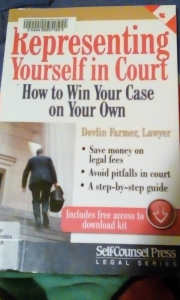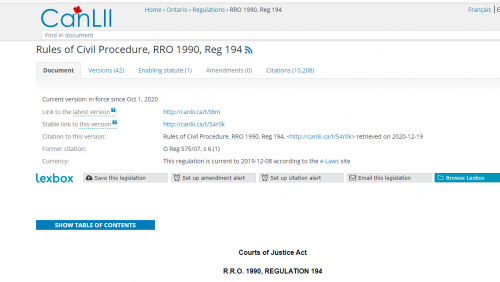
This piece is going to be a bit different. It’s an effort to answer a question: can interested parties also serve as experts in the same case? It will look at an example, using Ontario as a model.
The instinctive answer would be no, this is a serious conflict of interest. But let’s look a bit deeper. Remember, this is just for information, and there’s no need for anyone to overreact.
1. Important Links
Ontario Rules Of Civil Procedure
Ontario Law Society: Rule 3.4 (Conflicts Of Interest)
Canadian National Railway Co. v. McKercher LLP, 2013 SCC 39
Vaccine Choice Canada Lawsuit, October 2019
Vaccine Choice Canada Lawsuit, July 2020
2. Ontario Rules Of Civil Procedure
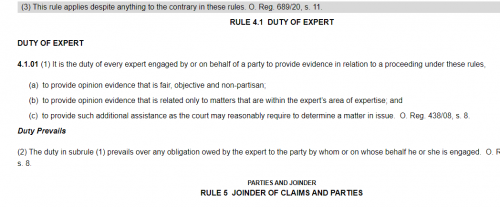
RULE 4.1 DUTY OF EXPERT
.
DUTY OF EXPERT
.
4.1.01 (1) It is the duty of every expert engaged by or on behalf of a party to provide evidence in relation to a proceeding under these rules,
.
(a) to provide opinion evidence that is fair, objective and non-partisan;
.
(b) to provide opinion evidence that is related only to matters that are within the expert’s area of expertise; and
.
(c) to provide such additional assistance as the court may reasonably require to determine a matter in issue. O. Reg. 438/08, s. 8.
.
Duty Prevails
.
(2) The duty in subrule (1) prevails over any obligation owed by the expert to the party by whom or on whose behalf he or she is engaged. O. Reg. 438/08, s. 8.
According to Rule 4.1.01(1) and (2), the answer likely is no. A person who is a Plaintiff or Defendant is by nature an interested party. If the person has a vested interest (financial or otherwise), then overcoming that conflict of interest would be difficult.
3. What Expert Reports Will Include (Ontario)
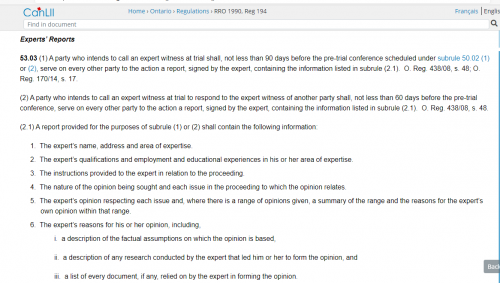
(2.1) A report provided for the purposes of subrule (1) or (2) shall contain the following information:
.
1. The expert’s name, address and area of expertise.
.
2. The expert’s qualifications and employment and educational experiences in his or her area of expertise.
.
3. The instructions provided to the expert in relation to the proceeding.
.
4. The nature of the opinion being sought and each issue in the proceeding to which the opinion relates.
.
5. The expert’s opinion respecting each issue and, where there is a range of opinions given, a summary of the range and the reasons for the expert’s own opinion within that range.
.
6. The expert’s reasons for his or her opinion, including,
i. a description of the factual assumptions on which the opinion is based,
ii. a description of any research conducted by the expert that led him or her to form the opinion, and
iii. a list of every document, if any, relied on by the expert in forming the opinion.
.
7. An acknowledgement of expert’s duty (Form 53) signed by the expert. O. Reg. 438/08, s. 48.
Rule 53.03 of Ontario Rules of Civil Procedure outlines what is expected by expert witness to submit in their reports to the Court, in advance of trial. It’s a pretty good outline for the contents.
4. OLS Rules Of Professional Conduct
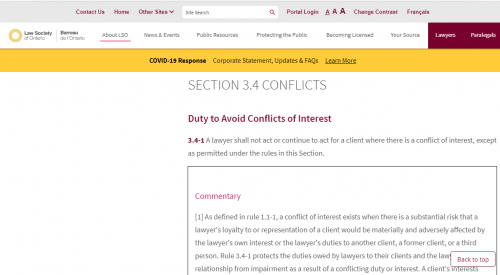
SECTION 3.4 CONFLICTS
Duty to Avoid Conflicts of Interest
3.4-1 A lawyer shall not act or continue to act for a client where there is a conflict of interest, except as permitted under the rules in this Section.
Commentary
[1] As defined in rule 1.1-1, a conflict of interest exists when there is a substantial risk that a lawyer’s loyalty to or representation of a client would be materially and adversely affected by the lawyer’s own interest or the lawyer’s duties to another client, a former client, or a third person. Rule 3.4-1 protects the duties owed by lawyers to their clients and the lawyer-client relationship from impairment as a result of a conflicting duty or interest. A client’s interests may be seriously prejudiced unless the lawyer’s judgment and freedom of action on the client’s behalf are as free as possible from conflicts of interest.
[2] In addition to the duty of representation arising from a retainer, the law imposes other duties on the lawyer, particularly the duty of loyalty. The duty of confidentiality, the duty of candour and the duty of commitment to the client’s cause are aspects of the duty of loyalty. This rule protects all of these duties from impairment by a conflicting duty or interest.
[7] A bright line rule has been developed by the courts to protect the representation of and loyalty to current clients. c.f. Canadian National Railway Co. v. McKercher LLP, [2013] 2 S.C.R. 649. The bright line rule holds that a lawyer cannot act directly adverse to the immediate legal interests of a current client, without the clients’ consent. The bright line rule applies even if the work done for the two clients is completely unrelated. The scope of the bright line rule is limited. It provides that a lawyer cannot act directly adverse to the immediate legal interests of a current client. Accordingly, the main area of application of the bright line rule is in civil and criminal proceedings. Exceptionally, the bright line rule does not apply in circumstances where it is unreasonable for a client to expect that the client’s law firm will not act against the client in unrelated matters.
Consent
3.4-2 A lawyer shall not represent a client in a matter when there is a conflict of interest unless there is consent, which must be fully informed and voluntary after disclosure, from all affected clients and the lawyer reasonably believes that he or she is able to represent each client without having a material adverse effect upon the representation of or loyalty to the other client.
Having an expert witness as a Plaintiff or Defendant is a conflict. It gets even trickier when there are other clients involved in the same case. The duty of the expert is to the court first and foremost. The Ontario Law Society, (a.k.a. Law Society of Upper Canada), has strict rules against members engaging in conflicts of interest.
5. Supreme Court: Bright Red Line Rule
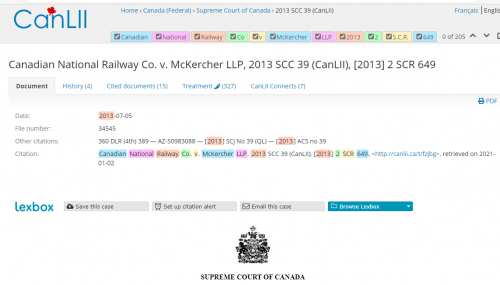
Canadian National Railway Co. v. McKercher LLP, 2013 SCC 39
Cases Cited
.
Referred to: R. v. Neil, 2002 SCC 70, [2002] 3 S.C.R. 631; MacDonald Estate v. Martin, 1990 CanLII 32 (SCC), [1990] 3 S.C.R. 1235; R. v. Cunningham, 2010 SCC 10, [2010] 1 S.C.R. 331; Cholmondeley v. Clinton (1815), 19 Ves. Jun. 261, 34 E.R. 515; Bricheno v. Thorp (1821), Jacob 300, 37 E.R. 864; Taylor v. Blacklow (1836), 3 Bing. (N.C.) 235, 132 E.R. 401; Rakusen v. Ellis, [1912] 1 Ch. 831; Strother v. 3464920 Canada Inc., 2007 SCC 24, [2007] 2 S.C.R. 177; Bolkiah v. KPMG, [1999] 2 A.C. 222; Moffat v. Wetstein (1996), 1996 CanLII 8009 (ON SC), 29 O.R. (3d) 371; Canadian Pacific Railway v. Aikins, MacAulay & Thorvaldson (1998), 1998 CanLII 5073 (MB CA), 23 C.P.C. (4th) 55; De Beers Canada Inc. v. Shore Gold Inc., 2006 SKQB 101, 278 Sask. R. 171; Toddglen Construction Ltd. v. Concord Adex Developments Corp. (2004), 34 C.L.R. (3d) 111.
(f) The Bright Line Rule
.
[27] In Neil, this Court (per Binnie J.) stated that a lawyer may not represent a client in one matter while representing that client’s adversary in another matter, unless both clients provide their informed consent. Binnie J. articulated the rule thus:
The bright line is provided by the general rule that a lawyer may not represent one client whose interests are directly adverse to the immediate interests of another current client — even if the two mandates are unrelated — unless both clients consent after receiving full disclosure (and preferably independent legal advice), and the lawyer reasonably believes that he or she is able to represent each client without adversely affecting the other. [Emphasis in original; para. 29]
[28] The rule expressly applies to both related and unrelated matters. It is possible to argue that a blanket prohibition against concurrent representation is not warranted with respect to unrelated matters, where the concrete duties owed by the lawyer to each client may not actually enter into conflict. However, the rule provides a number of advantages. It is clear. It recognizes that it is difficult — often impossible — for a lawyer or law firm to neatly compartmentalize the interests of different clients when those interests are fundamentally adverse. Finally, it reflects the fact that the lawyer-client relationship is a relationship based on trust. The reality is that “the client’s faith in the lawyer’s loyalty to the client’s interests will be severely tried whenever the lawyer must be loyal to another client whose interests are materially adverse”: Restatement of the Law, Third: The Law Governing Lawyers (2000), vol. 2, § 128(2), at p. 339
The “bright red line” has been explicitly stated to lawyers who represent clients with opposing interests. However, the idea of representing an expert witness is an interesting twist.
Though the language differs across jurisdictions, experts are considered “Friends of the Court”, neutral people who can provide unbiased information and opinion for a Judge and/or Jury.
True, experts are paid for their time by someone. That alone does not render them useless, as they do have a role to play. But what happens when the Expert has a vested interest in the outcome of the case?
While the Lawyer’s Clients (the Experts and non-Experts) could conceivably agree that this conflict of interest should be set aside, what about opposing Parties? Could it not result in an unfair Trial by stacking the deck against them?
Something seems off about this.
6. Such A Conflict In Ongoing Case?!?!
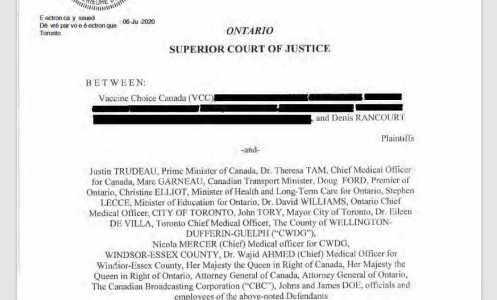
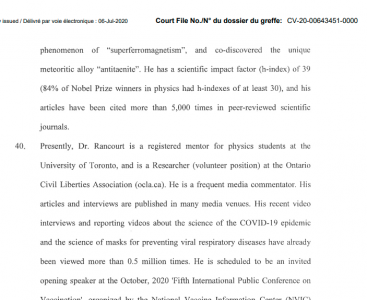
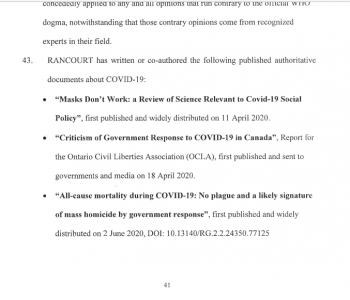
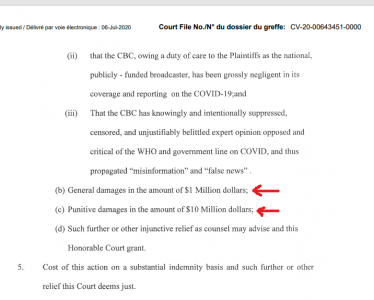
Pages 39-43 of the Statement of Claim spell out the qualifications and education of Denis Rancourt. And yes, it is quite impressive. However, no facts are pleaded to demonstrate that Rancourt has been harmed in any way by these restrictions, or that he has suffered any losses. He is clearly being introduced as an expert witness.
It’s not just that Rancourt is to be paid a fee for his time and trouble. That would be one thing. Here, he is a Plaintiff in an $11 million lawsuit — which he doubles as an Expert in. It stands to reason that he could make $1 to $2 million is the case is successful, which is a conflict of interest. Even if he is unbiased, this conflict will not be lost on the Court — or the other lawyers.
Is this normal? Are Experts typically interested Parties in the cases they participate in? Is there some exception or clause in the law that allows for this to happen? Is this a common practice that just isn’t discussed much? This appears to be the sort of thing that would jeopardize fair proceedings, but who knows?
Note: this is not an attempt to defend the nonsense that has gone on Federally, Provincially, Municipally and even in other countries. All of those people should be tried for crimes against humanity. The CV hoax is extensively outlined in this series. However, all problems need to be called out.
There are of course other issues, such as missing service addresses, and no defenses filed, but they have been addressed elsewhere.
The Statement of Claim was released publicly, but with most Plaintiff names redacted. Anyone who wants the unedited version can get a copy for free from the Ontario Superior Court (Civil Division) in Toronto.

